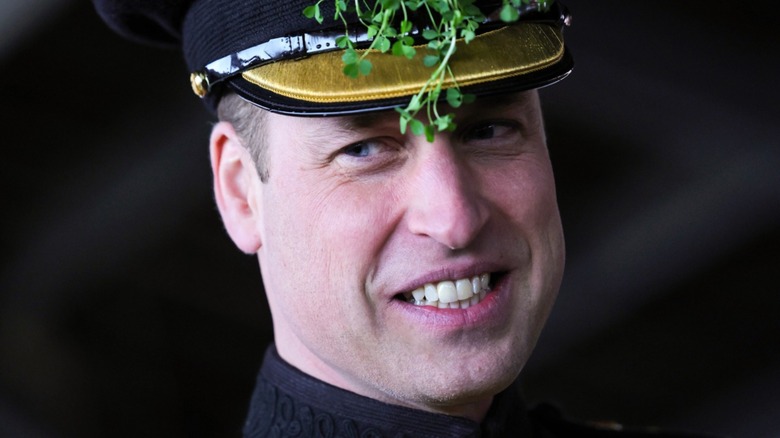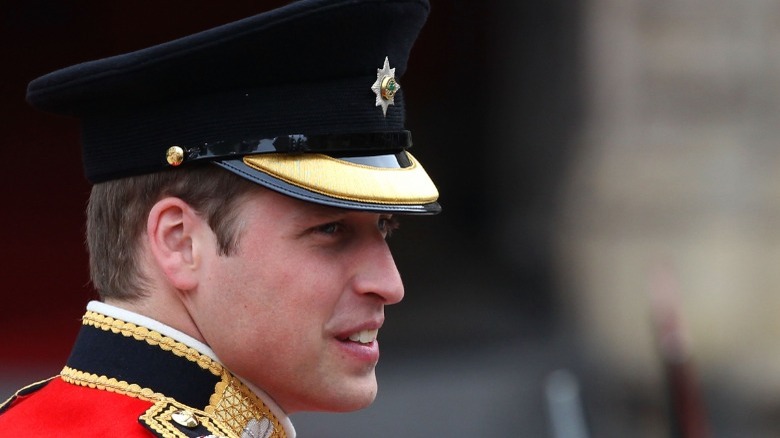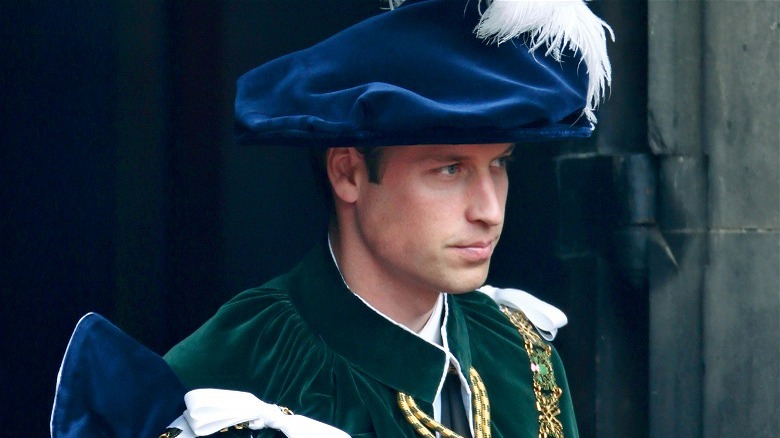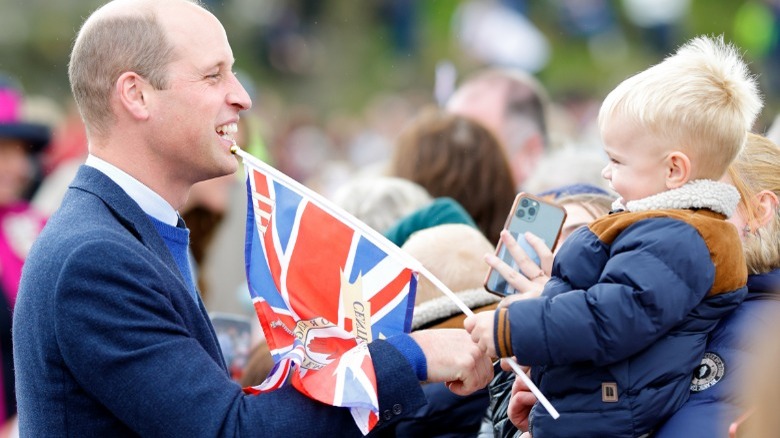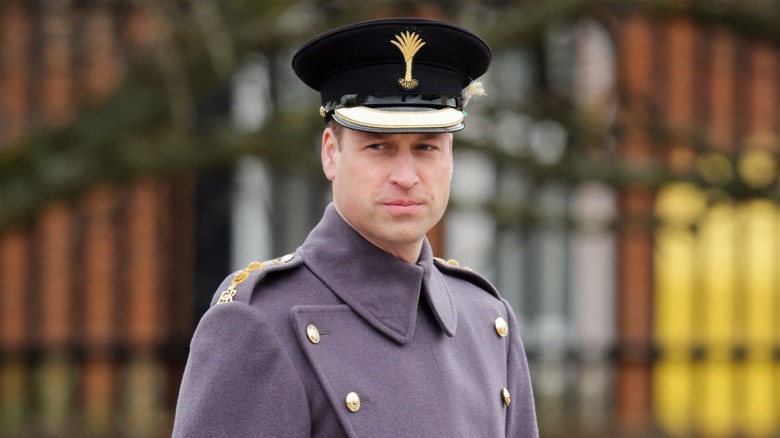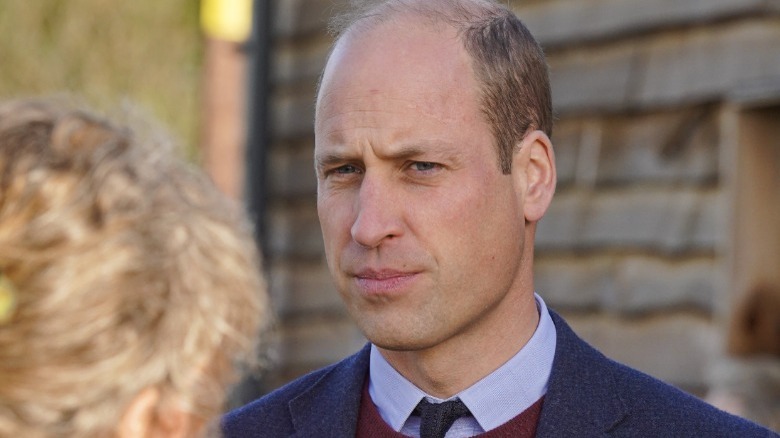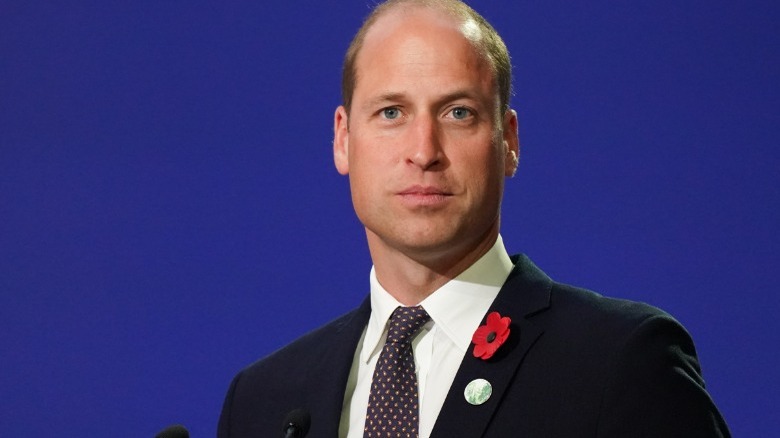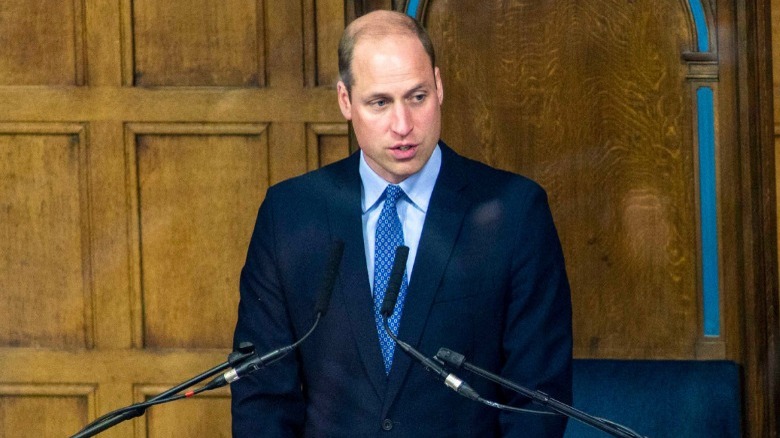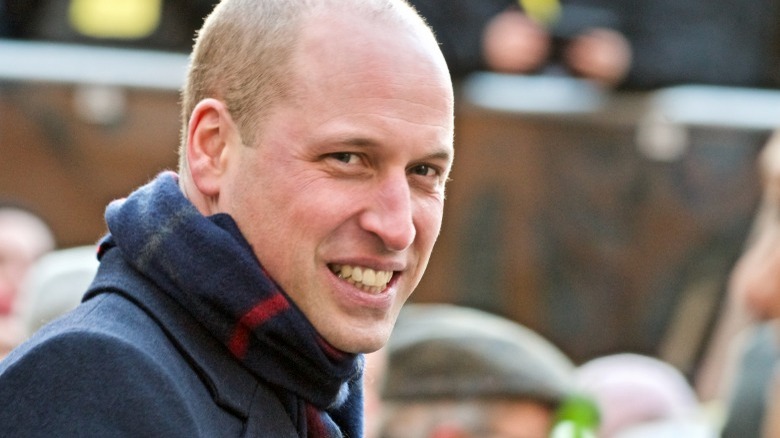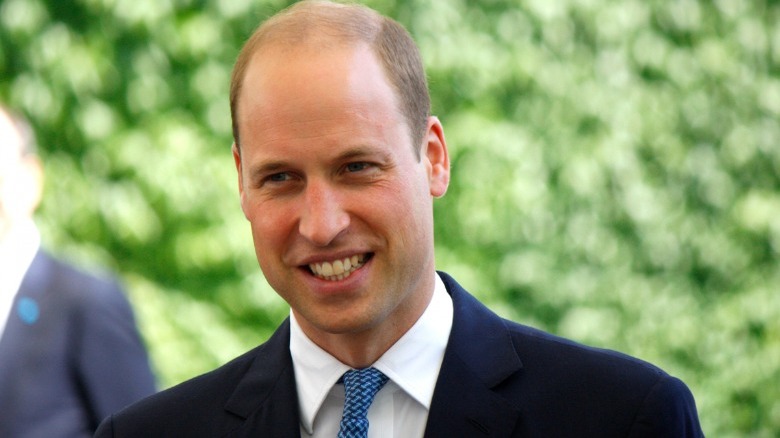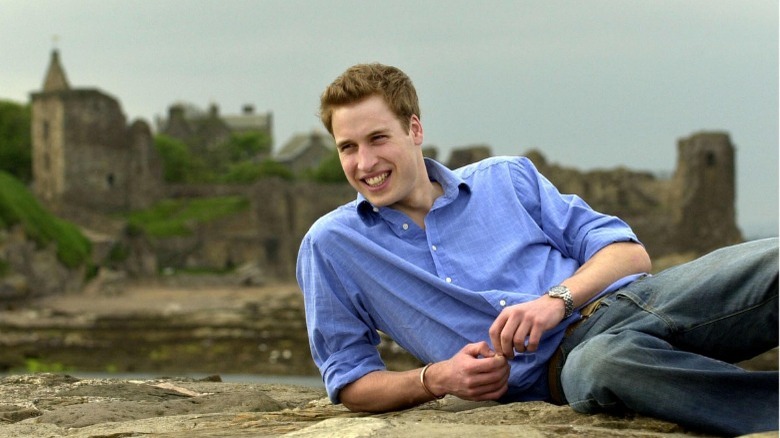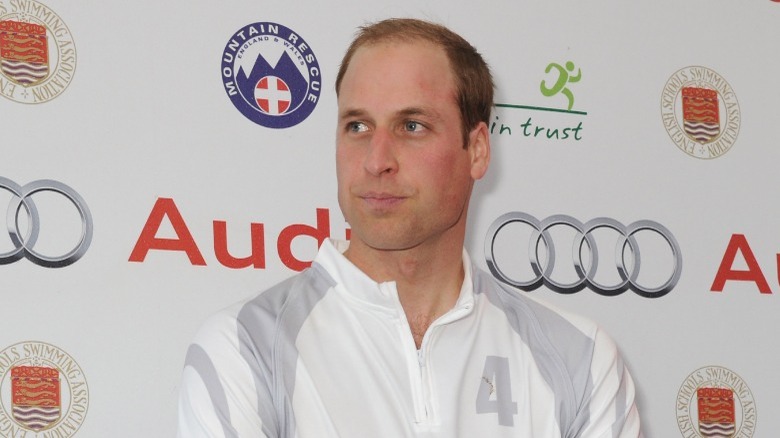All Of Prince William's Royal Titles Explained
As the eldest son of King Charles III and Princess Diana, Prince William has spent his whole life preparing to assume the throne of the monarchy. There are a number of rules the future king must follow, and he is expected to live his life in service to the crown. (That's why it was so shocking when his brother, Prince Harry, opted out of continuing his royal duties.)
Over the years, William's exact role in the monarchy has shifted numerous times. As he has grown up in the public eye, he has taken on a number of roles and duties. For various reasons at important benchmarks in his path to the throne, William has been given numerous royal titles. He's not just Prince William; according to The London Gazette, his full name is actually "His Royal Highness Prince William Arthur Philip Louis, Duke of Cornwall Rothesay and Cambridge, Earl of Carrick and Strathearn, Baron of Renfrew, Baron Carrickfergus, K.G., K.T., Lord of the Isles and Prince and Great Steward of Scotland, Prince of Wales and Earl of Chester." But ... what does all of that mean? Read on for a description of all of Prince William's royal titles, explained.
Duke of Cambridge
When Prince William married Princess Catherine in 2011, he received a special wedding gift from his grandmother, Queen Elizabeth II. The day of the wedding, the palace announced a number of royal titles for the future king, including naming him and his wife the Duke and Duchess of Cambridge. For the following decade, this was the main title that William and Catherine were known by.
The title refers to the county in England that is home to the historic university of the same name. The palace noted in their announcement of the title that it was previously an earldom since the 1300s, eventually created Duke of Cambridge in the 1700s. The title was then passed down and recreated numerous times over the centuries. "Cambridge existed as a marquessate from 1917 when it was conferred on Queen Mary's brother till 1981 when the 2nd Marquess died and the title became extinct," The Royal Household wrote in its official statement about the queen's gift.
The Duke and Duchess of Cambridge first visited Cambridge the year after their wedding. On that trip, Prince William gave a speech about what the title meant to him and his wife. According to the BBC, he said, "We both feel immense pride at being associated with Cambridge, a place renowned the world over for its dynamism, beauty, and learning, and it is lovely for us to be here together today."
Earl of Strathearn
The same day Prince William and Princess Catherine were named Duke and Duchess of Cambridge, the prince also received the title Earl of Strathearn. "Strathearn has had royal connections since Robert Stewart, High Steward of Scotland, was created Earl of Strathearn in 1357," The Royal Household wrote in its official announcement of the title. The earldom (and occasional dukedom) came and went over the centuries, eventually going extinct in 1943 until Queen Elizabeth II recreated it for her grandson.
As a member of the royal family of the United Kingdom, Prince William helps rule over not just England but Scotland. Consequently, "Earl of Strathearn" was Prince William's title whenever he was in Scotland. However, it isn't his only Scottish connection. The year after his wedding, Queen Elizabeth II bestowed a knighthood on her grandson, naming him to the Order of the Thistle, the highest honor in the country. At the ceremony, according to the BBC, Prince William pledged, "I shall maintain the honor and dignity of the most ancient and most noble Order of the Thistle to the best power if God let."
In 2021, the Earl of Strathearn gave a speech to the Church of Scotland, having been named lord high commissioner of the church. "Her Majesty has always attached the greatest importance to the personal appointment of a lord high commissioner each year," he said (via The Royal Household). "It signals the reaffirmation of these values and acknowledges the integral role the church plays in Scottish life."
Baron Carrickfergus
In addition to his royal titles for England and Scotland, Prince William received a title on his wedding day for use in Northern Ireland. He was created Baron Carrickfergus, a reference to an old Northern Irish town that is the location of an ancient, still-standing castle. According to The Royal Household, the title hasn't been used since the 1800s. "Carrickfergus is County Antrim's oldest town," the palace wrote. "The word means Rock of Fergus, and as an urban settlement it predates Belfast."
When Prince William was given the title, some residents were unhappy with its significance, given centuries-old tensions between England and Ireland. "Baron Carrickfergus certainly lays claim to disputed land between the Irish and the British, one settled by Protestant planters in the 16th century when the native Irish were driven off," Niall O'Dowd wrote in an op-ed for Irish Central. In other words, critics felt that Prince William's acceptance of the title was an effort to reassert British supremacy over Northern Ireland.
Prince William finally visited the namesake location in 2022, more than a decade after he took on the title. According to local reports, Prince William and Princess Catherine were warmly received by residents. Carrickfergus citizen Davy Hilditch told The News Letter that he was glad the royals had finally made a visit. "They've taken their time, so they must've been taking a good look at us before they came!" he said.
Prince of Wales
Upon his father's accession to the throne, Prince William became William, Prince of Wales. The title is given to the direct heir, and now that his father is King Charles III, Prince William is next in line. The day after Queen Elizabeth II died, King Charles III gave a speech announcing his son as the new Prince of Wales. "Today, I am proud to create him Prince of Wales, Tywysog Cymru, the country whose title I have been so greatly privileged to bear during so much of my life and duty," he said (via The New York Times). "With Catherine beside him, our new Prince and Princess of Wales will, I know, continue to inspire and lead our national conversations." The title became official a few months later, when The London Gazette printed an official record of the passing of the Great Seal of the Realm.
Prince William and Princess Catherine visited the country weeks after becoming Prince and Princess of Wales, touring a lifeboat station and a church that operates a food bank. Reverend Steven Bunting, who met the royals on their visit, told People that he was impressed by their dedication to their titles. "He talked about learning Welsh and shared some Welsh phrases he's trying to do," the reverend recalled. " ... He is throwing himself into the new role."
This title is likely especially meaningful to Prince William. His mother, Princess Diana, remained Princess of Wales until her death, even after leaving the royal family.
Duke of Cornwall
Prince William and Princess Catherine received numerous other titles upon the death of Queen Elizabeth II. As the next in line for the throne, William and Catherine became the Duke and Duchess of Cornwall, titles previously held by King Charles III and Camilla, the queen consort. Before the official announcement came, The Mirror noted that their titles had been changed on the royals' Twitter account first.
According to the Duchy's official website, King Edward III established the estate in 1337 as an inheritance for his son, Prince Edward. Ever since, the duchy has been passed down to the eldest son of the reigning monarch, who is now Prince William. Unlike the majority of Prince William's other titles, which are largely ceremonial, the Duchy of Cornwall comes with an immense sum of money and a large amount of land. The duchy's website claims that the estate — reportedly worth over a billion pounds — generates the funds that support the work of the Prince of Wales.
Prince William knew he would inherit the title and the land that came with it, so he began investigating what to do with his newfound power years in advance. In the 2019 ITV documentary "Prince Charles: Inside the Duchy of Cornwall," Prince William pledged to continue the sustainability work his father had begun on the land. "Rest assured I'm not going to rock the boat. I'll do much the same as what my father's doing," he said (via People).
Duke of Rothesay
As was the case when he married Princess Catherine, when Queen Elizabeth II died, Prince William received a title to be used in Scotland. He is now known as the Duke of Rothesay while within the country, a title that has been in use since 1398.
The King of England is also King of the Scots, and all the way back in 1469, the Parliament of Scotland passed an act confirming that whoever is heir to the Scottish throne will be known as the Duke of Rothesay. King Charles III explained as much in his address after Queen Elizabeth II died, telling the nation, "As my heir, William now assumes the Scottish titles which have meant so much to me" (via The New York Times). Rothesay, for the record, is a town on the Scottish Isle of Bute.
In 2021, while speaking to the Church of Scotland in his role as the lord high commissioner, Prince William told the assembly about the royal family's emotional connection to the country. ”Scotland is incredibly important to me and will always have a special place in my heart," he said (via The Royal Household). "I've been coming to Scotland since I was a small boy." After noting that his grandmother and father both adored Scotland, he added, "My childhood was full of holidays having fun in the fresh air and swimming in lochs, family barbecues with my grandfather in command, and yes — the odd midge."
Earl of Carrick
In addition to being created Duke of Rothesay, Prince William received another dynastic title related to Scotland when his father acceded to the throne upon the death of Queen Elizabeth II. While in Scotland, Prince William is also known as Earl of Carrick.
Carrick — different from the similarly named Carrickfergus — is a district in the south of Scotland. Interestingly, this title used to be held by Robert the Bruce, one of the main characters in "Braveheart" and the Chris Pine-starring Netflix film "Outlaw King." In fact, a book from 1910 called "The Complete Peerage of England, Scotland, Ireland, Great Britain, and the United Kingdom" records the Earls of Carrick dating back to the 1100s.
While speaking to the Church of Scotland in 2021, Prince William elaborated on his own personal connection to the country. Scotland, it seems, remained an important part of his life even as he grew up. "I spent four very happy and formative years studying in St. Andrews," he recalled (via The Royal Household). "The town and the students left me alone to get on with student life, allowing me to share their freedoms and their pubs. I did training as a pilot in Inverness. As well as enjoying the camaraderie of my colleagues, it was a privilege to see the majestic sights of Scotland from the air. In short, Scotland is the source of some of my happiest memories."
Baron of Renfrew
It turns out that the heir to the throne receives a number of titles related to the royal family's presence in Scotland. In addition to being named Duke of Rothesay and Earl of Carrick, Prince William received the title Baron of Renfrew when his father became King Charles III after Queen Elizabeth II died.
Renfrew is a town on the outskirts of Glasgow. According to Scotland Magazine, the exact meaning of this title is no longer clear; debate exists over whether "Baron of Renfrew" is a peerage or a holdover from the feudal era of Scottish history. Regardless, the title is yet another ceremonial one, given automatically to whomever is heir to the throne.
What is more clear, however, is the title's personal meaning for Prince William's family. When Princess Diana married King Charles III, The Washington Post reported that the couple used this title as a sort of code name when they first began dating. Trying to keep their relationship from leaking to the press, Princess Diana had to be careful who she told about her incredibly famous suitor. To that end, when her friends asked her who she was seeing, Princess Diana would tell them her boyfriend's name was "Charles Renfrew."
Lord of the Isles
The Scottish titles never end! In addition to being named Duke of Rothesay, Earl of Carrick, and Baron of Renfrew, Prince William is now known as Lord of the Isles now that his father has acceded to the throne. Like the other titles, this one is largely ceremonial; this time, the title refers to the islands off the Scottish coast. This is the only title of Prince William's that has existed for even longer than the Kingdom of Scotland has been around, let alone for as long as Scotland and England have been united.
Though Prince William has been open about how much the country of Scotland means to him, he has also confessed to having many sad memories there as well. During that same 2021 speech to the Church of Scotland, he recalled being in Scotland during one of the worst days of his life. Still, the country managed to comfort him.
"I was in Balmoral when I was told that my mother had died," he said (via The Royal Household). "Still in shock, I found sanctuary in the service at Crathie Kirk that very morning. And in the dark days of grief that followed, I found comfort and solace in the Scottish outdoors. As a result, the connection I feel to Scotland will forever run deep."
Prince and Great Steward of Scotland
Prince William has one final title related to his role in Scotland. While still remaining Duke of Rothesay, Earl of Carrick, Baron of Renfrew, and Lord of the Isles, Prince William is also called Prince and Great Steward of Scotland. This title is actually two roles combined into one, an artifact of the time when the King of Scots was different from the King of England. The title has been used for a member of British royalty since 1371, and it was the reason for the naming of the House of Stuart, which ruled the United Kingdom until the death of Queen Anne.
His father took his Scottish roles very seriously, and Prince William has also repeatedly expressed his dedication to the country. Speaking to the Church of Scotland in 2021, the future king remembered one other significant life event that took place in the country; after all, it's where he met Princess Catherine while they were both students at St. Andrews.
Together, Prince William and Princess Catherine have even started to pass their love of Scotland on to the next generation of the royal family. "George, Charlotte, and Louis already know how dear Scotland is to both of us, and they are starting to build their own happy memories here too," Prince William said (via The Royal Household). "We have no doubt they will grow up sharing our love and connection to Scotland from the Highlands to the Central Belt, from the islands to the borders."
Earl of Chester
Prince William received one final title when Queen Elizabeth II died and his father became King Charles III. In addition to everything else, he is also Prince William, Earl of Chester.
This is a title relating to the city of Chester in England, located in the county of Cheshire. According to Cheshire Live, this was a once-powerful title until the 1300s and is now mostly ceremonial. As with most of the other titles held by Prince William, this one simply comes with the territory, attached to the fact that he is next in line for the throne.
Prince William has visited Chester several times throughout the years. In 2018, he and Princess Catherine attended the funeral services of the Duke of Westminster, which were held in the town. He has also participated in numerous polo matches in Chester, competing in an event in 2011, one in 2012 (also attended by celebs like Jennifer Lawrence and then-boyfriend Nicholas Hoult), and one in 2013. The matches, all of which the future king won, raised funds for charities like the English Schools Swimming Association, a group Prince William has worked with for years.
